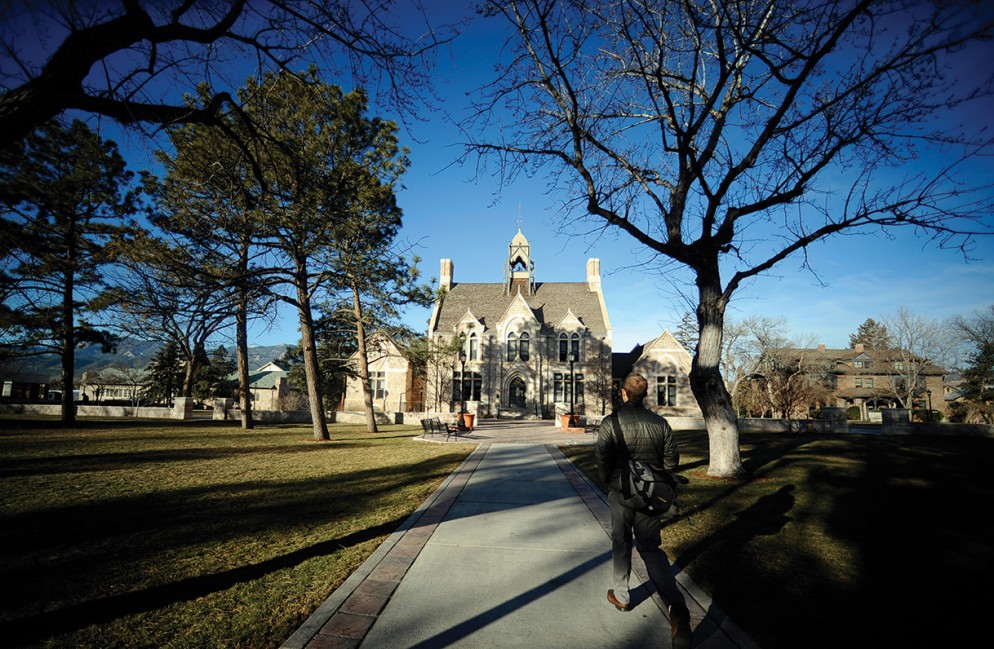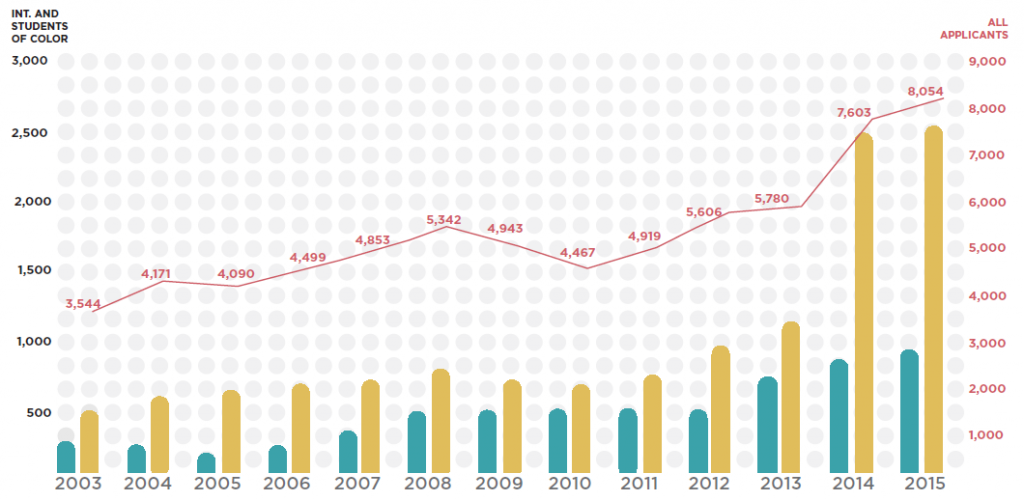Does the number 8,054 mean anything to you? If not, then it soon will.
With all it has to offer, Colorado College has always been a desirable destination for students, faculty, and staff. That desirability has never been more obvious than in the 2014-15 application cycle. This year, at the time of writing, CC has received 8,054 applications for admission — more than any other in its history. That’s an increase of nearly 6 percent since 2014, and a 33 percent increase since 2013. Matthew Bonser ’98, director of admission-systems, operations, and international, hailed this drastic increase in numbers as “incredibly significant.”
“As we communicate clearly what the college does well, that’s obviously attractive to an increasing number of people,” he said. “We do amazing things here at Colorado College, and communicating that effectively can only help our reputation as a top liberal arts college, both domestically and internationally.”
One significant factor in the increased applications is the result of a partnership that CC formed in 2013 with QuestBridge, a nonprofit organization that matches high-achieving, underserved students with higher-education opportunities. As part of a consortium of 35 colleges and universities across the country, Colorado College’s reach has expanded greatly across areas of the country where it once lacked traction and representation.
“It’s gratifying that we are reaching some of the best and brightest students across the country and world and that, when admitted to CC, they are choosing to enroll in record numbers,” said Mark Hatch, Colorado College’s vice president for enrollment.
“Furthermore, we have heard from several faculty that the students are curious and motivated, elevating the intellectual exchange among peers and professors,” Hatch said.
With this ever-increasing application pool, the Admission Office is responsible for supporting and surpassing the high academic and community standards that CC has exhibited throughout its history. This includes the enrollment of a wide variety of students, domestically and internationally.
“The whole point of being part of an educational community,” Bonser said, “is to be around a great set of faculty to learn from and with, as well as a diverse student body to do the same. The way people approach a topic of discussion, be it in a classroom or over dinner, is informed by where and what they come from.”
Statistics support Bonser’s thoughts. Since 2010, the number of international applicants has gone from 463 to 885, and for students of color it has risen from 631 to 2,450. That’s an increase of 62 percent and 288 percent, respectively. Enrollment statistics mirror these increases. From 2003-04 to 2013-14 the percentage of students of color on campus increased from 14.8 to 24.6, and the number of international students grew from 2 percent to 7 percent.
Additionally, and perhaps more startling, are the statistical changes over roughly the past decade. In 2003, the college received 3,544 applications and admitted 51.3 percent of those applicants. In 2014, the college received 7,603 applications and accepted 17.9 percent.
Although not all of these applicants enroll at the college, this dramatic increase in the applicant pool ensures that the makeup of the college continues to grow and change for the better.
“While it’s difficult to turn down so many qualified applicants, we are hearing from faculty and staff that the increase in talent and diversity translates into dynamic conversations and debates in and out of the classroom,” Hatch said.
Dominique Wells ’15, from Durban, South Africa, is a fellow in the Admission Office, where she assists in the recruiting and interview processes for prospective CC students. Before CC, she attended the Waterford Kamhlaba United World College of South Africa in Swaziland. “It’s been incredible to see the growth in interest in CC over my time here,” she said.
“Change has challenged the way we interact with each other as a community and has spurred more stimulating discussion about issues both within the United States and around the world.”
Reaching and retaining a more diverse set of students is one thing, but maintaining a commitment to diversity within a community of thousands is another prospect entirely. CC is working toward this ideal in many ways, but one way that stands out is the changes and improvements the college has made to preexisting college programs such as the Bridge Scholars Program. Begun in 1996 by Professor Ralph Bertrand, it was designed to support matriculating students interested in science and medicine.
Today, as psychology professor and associate dean of the college Emily Chan said, the Bridge Program “focuses on welcoming first-generation students to the college, as well as those who attended high schools with limited opportunities for advanced coursework.”
Ensuring the continued growth and success of the college is the ambition of all who know and love CC. This love is demonstrated in thousands of ways, from classroom performance and extracurricular involvement as students, to alumni giving and “gentle persuasion” from alumni to their younger family members to consider a CC education. With these future Tigers in mind, the college has “also seen a corresponding increase in legacy applicants” during recent years, Hatch said.
“It’s incredibly gratifying to know that alumni want the same experience for their sons and daughters, or grandsons and granddaughters. We pay careful attention to these applicants, particularly because many legacies are better prepared for what CC will bring, given their familiarity with the college. This familiarity shines through in their essays and interviews, and we welcome their families back to the college with open arms. It is vital to mention that given our level of selectivity, legacy status is no guarantee for admission. It can certainly add a powerful tip to an application if all else is equal in the applicant’s file and we encourage all those interested in applying to Colorado College to reach out to us for more information.”
Of course, there are financial costs involved with this increasingly qualified, global applicant pool. Given the hugely diverse backgrounds of applicants, the college has been forced to have some difficult discussions about educational financing. The mission as an educational institution of the highest quality, committed to forming a diverse and inclusive community, has never wavered, but the college has had to confront issues surrounding student affordability and financial assistance. As a private college, CC is a tuition-driven institution. And although “we pay close attention to sculpting a class with exceptional diversity,” it is also true that “tuition dollars support more than two-thirds of the operating budget for each year,” Hatch said.
As much as the college would like to, funding every qualified student simply isn’t an option.
Hatch pointed out that when CC’s financial aid packages are combined with loans and work-study, “our average level of indebtedness at graduation is far less than the national average.” Assistance for students comes in many forms, including that of the Walton Family Foundation’s $10 million matching grant for high-need and first-generation college students. Received in 2010, the Walton grant challenged the college’s alumni and friends to match that amount to create $20 million in new endowed scholarship funds by this year (2015). At the time of writing, the college has secured commitments for the $10 million.
With that money committed, as well as an increasingly qualified and diverse student body, the future of Colorado College — more widely known and well-respected than ever before — looks incredibly bright.
| 2003 | 2004 | 2005 | 2006 | 2007 | 2008 | 2009 | 2010 | 2011 | 2012 | 2013 | 2014 | 2015 | |
|---|---|---|---|---|---|---|---|---|---|---|---|---|---|
| International | 243 | 214 | 198 | 211 | 284 | 410 | 432 | 463 | 472 | 471 | 673 | 776 | 885 |
| Students of Color | 484 | 530 | 653 | 700 | 704 | 822 | 697 | 631 | 791 | 915 | 1,029 | 2,422 | 2,450 |
| All Applicants | 3,544 | 4,171 | 4,091 | 4,409 | 4,853 | 5,342 | 4,943 | 4,467 | 4,919 | 5,606 | 5,780 | 7,603 | 8,054 |

